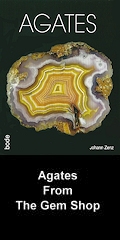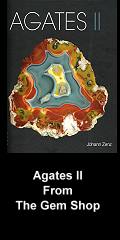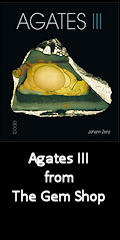This gorgeous Laguna agate displays complete fortifications in the most astonishing array of colors from an unusual dark red through delicate purples. The fine fortification lines outline an opening filled with crystals. If you look at the images where the stone is oriented vertically, you may notice the outline of La Virgen de Guadalupe with her spectacular corona. You will find many quotes similar to this one on line: "The Virgin of Guadalupe, the patroness of the Americas, is the symbolic mother of Mexicans everywhere, the symbol of Mexican identity, history, and culture." Is it so surprising then that her image should appear in a beautiful Mexican agate?
Laguna agates are found near Ojo Laguna in Chihuahua. In Zenz' first book he says, "Many collectors consider the [Laguna] agates ... to be the best of their kind in the whole world." In Agates II the article by Pat McMahan describes the Laguna vein. After digging there, he concluded that the agate forms from the surface down, with the best quality material in the upper layers. Agates III includes a couple of stunning Laguna photos in the write ups about different collectors. All of these examples are solid, without our agate's mystical opening where the Lady resides. You may have observed that I favor stones with such openings where others sometimes see "faults." I have purchased slabs of rough which have someone else's idea of where cabs should be cut. Invariably the markings are from standard-shaped templates, the person moved the (usually) oval template opening around and marked up the stone, scrupulously avoiding the little holes with crystals in them. This baffles me. You can see why I love Gary Wilson's stones: he appreciates the beautiful openings and does not confine himself to cutting standard ovals! This stone was cut to take full advantage of the way it grew naturally.
Surely everyone knows the outlines of the story of La Virgen de Guadalupe: On December 9, 1531 the peasant Juan Diego had a miraculous vision on the Hill of Tepeyac of a young woman who spoke to him in Nahuatl, asking him to build a church in her honor. He "recognized" her as the Virgin Mary. The archbishop did not believe Juan Diego's story, so he demanded a sign. The lady appeared to him again, told him to gather flowers in his cloak and return to the archbishop. When he opened the cloak to present the flowers to the archbishop, the flowers fell to the floor and revealed the image of Guadalupe in the cloak. Two of the references below go into (excruciatingly) detailed scholarly criticism of the story if you have an interest. Personally I find it more interesting to study "how something is true" rather than find all the ways it could not possibly be so. So I find it fascinating that long before the Spaniards arrived, the indigenous people celebrated great feasts at Tepeyac to Tonantzin, "Our Mother."
Incidentally, many of you know that I live in San Diego, so might wonder whether my town was named after Juan Diego. No, not so. First of all, Juan Diego was not canonized (officially recognized as a saint by the Catholic Church) until 2002, thus it would not have been correct to call him "San" Diego before that time. Cabrillo named the place "San Miguel" when he arrived on September 28, 1542, but that name did not stick. When Vizcaino sailed into our beautiful harbor on November 10, 1602 he (apparently) named the area after his flagship, the San Diego. Through a convoluted story it turns out that San Diego is another name for St. Didacus. A contributing factor in the name choice could have been fact that Vizcaino's crew disembarked with their "diegos" (heavy swords) (perhaps to help them get through the immense forest that skirted the ocean?). The forest included trees with fruit similar to the Spanish diego pear. Vizcaino did not record the basis for his decision to call the area San Diego, so we can only speculate, but there seem to have been a lot of diegos involved. Wouldn't it be a wonder if remnants of that beautiful forest remained here today? We do have forested areas in our mountains, but even those are being devastated by climate change. Our pines and oaks are being attacked by invaders and are less and less able to defend themselves because of drought. And then there were the wildfires of 2003 and 2007. Now I'm off to figure out what those white-flowered diego fruit trees are AND what the First Nations people called this area before it was "discovered." But I digress.
Returning to the agate itself, Melody (see books below) mentions that Laguna agate can restore a state of openness and acceptance of that which "is" in the face of depression. Her encyclopedic work, the foundation for the work of many metaphysical healers, raises questions as to how one person could have produced such a volume of information and whether that information has any basis at all. First we must acknowledge that her work represents a lifetime of research. The acknowledgements in her books go on for pages and pages, listing all those who have contributed to that research. She mentions in her 1995 work, "The information... has been derived from 'hands-on' experience, geological research, folklore, experimentation, and channeled information; the channeled information and the experiences have both been validated via further experimentation and in a controlled environment." Now I was trained as a scientist, and most scientists have no interest in metaphysics to begin with, much less any type of information from channeling. Yet any remotely sensitive person knows that some stones feel very special, some call to us, some don't. Why is this? To help answer these questions, why not consider the work of someone who has spent a lifetime on it? We "scientists" would do well to consider whether Hamlet is correct when he says, "There are more things in heaven and earth, Horatio,/Than are dreamt of in your philosophy."
Well another little adventure draws to a close. Thank you for joining me! I hope you will order this lovely set and enjoy an opportunity to contemplate mystery.










